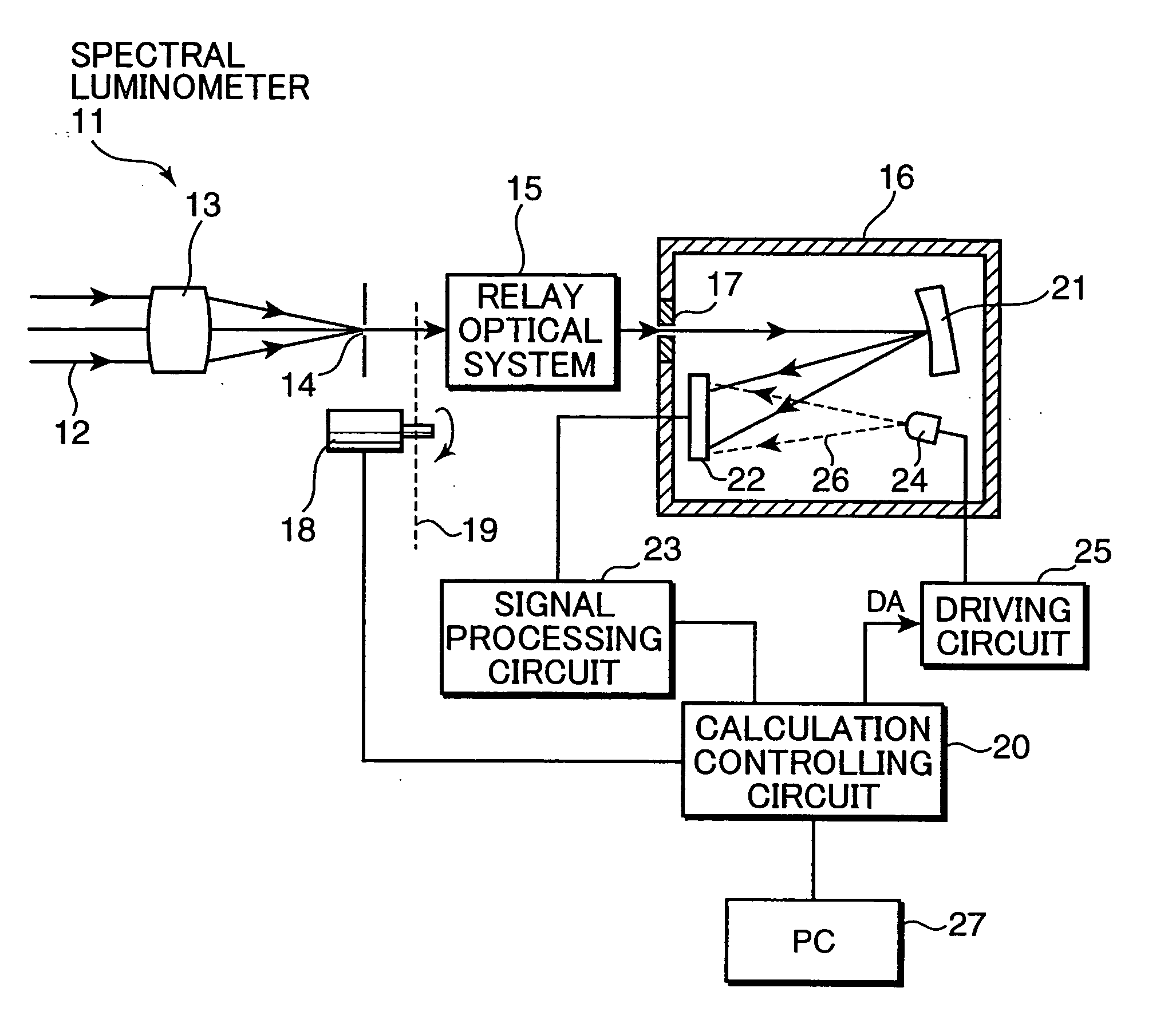Light measuring apparatus and a method for correcting non-linearity of a light measuring apparatus
a light measuring apparatus and nonlinearity technology, applied in the direction of optical radiation measurement, instruments, spectrophotometry/monochromators, etc., can solve the problem of not having linearity normally required for measuring apparatuses, requiring considerable labor and time for adjustment, and requiring large facilities. , to achieve the effect of high precision and efficient correction of nonlinearity
- Summary
- Abstract
- Description
- Claims
- Application Information
AI Technical Summary
Benefits of technology
Problems solved by technology
Method used
Image
Examples
first embodiment
[0043]FIG. 1 is a block diagram showing a construction of a spectral luminometer 11 according to a first embodiment of the present invention. This spectral luminometer 11 has a function of correcting the discontinuity of an input / output characteristic resulting from the switching of a gain as shown in FIG. 18. Light being measured or measurement light 12 is converged toward a measurement area restricting opening 14 by a light receiving optical system 13 and is caused to form an image of the measurement area restricting opening 14 and converged toward an incidence opening 17 of a polychrometer 16 by a relay optical system 15. A shutter 19 driven by a driving device 18 is provided behind the measurement area restricting opening 14. The driving device 18 is controlled by a calculation controlling circuit 20. The shutter 19 is closed while no measurement is conducted and while a correction to be described later is made, whereas it is opened during a measurement to control the incidence ...
second embodiment
[0082]FIG. 5 is a block diagram showing a construction of a spectral luminometer 31 according to a second embodiment of the invention. This spectral luminometer 31 is similar to the aforementioned spectral luminometer shown in FIG. 1, and no description is given on corresponding parts and elements thereof by identifying them by the same reference numerals. What should be noted is that the light receiving sensor array 22 is comprised of silicon photodiodes, the amplifiers Al for the current-to-voltage conversion are provided for the respective photodiodes D1 to Dn as shown in FIG. 2, and the gains (sensitivities) are switched by switching the feedback resistors R1, R2; R4, R5, R6 of the amplifiers A1, A2 in the aforementioned spectral luminometer 11, whereas a light receiving sensor array 32 is a CCD and the gains (sensitivities) are also switched according to integration times of electric charges stored into the CCD in the spectral luminometer 31.
[0083] Accordingly, this spectral l...
third embodiment
[0112]FIG. 9 is a block diagram showing a construction of a spectral luminometer 71 according to a third embodiment of the present invention. This spectral luminometer 71 is similar to the aforementioned spectral luminometer 31, and no description is given on the corresponding parts and elements thereof by identifying them by the same reference numerals. This spectral luminometer 71 is further provided with an integrating sphere 72 having a paint of high reflectivity and high dispersing property applied to the inner surface thereof, and a light source 73 provided therein.
[0113] When a driving circuit 74 causes the light source 73 to emit light in accordance with an emission control signal from the calculation controlling circuit 20b, this output light is diffused and reflected by the inner surface of the integrating sphere 72 to illuminate a sample 76 placed at a sample opening 75. A component 77 of the light reflected by the sample in an observing direction is received by a light ...
PUM
 Login to View More
Login to View More Abstract
Description
Claims
Application Information
 Login to View More
Login to View More - R&D
- Intellectual Property
- Life Sciences
- Materials
- Tech Scout
- Unparalleled Data Quality
- Higher Quality Content
- 60% Fewer Hallucinations
Browse by: Latest US Patents, China's latest patents, Technical Efficacy Thesaurus, Application Domain, Technology Topic, Popular Technical Reports.
© 2025 PatSnap. All rights reserved.Legal|Privacy policy|Modern Slavery Act Transparency Statement|Sitemap|About US| Contact US: help@patsnap.com



